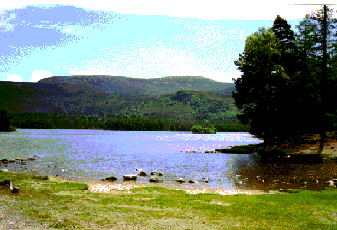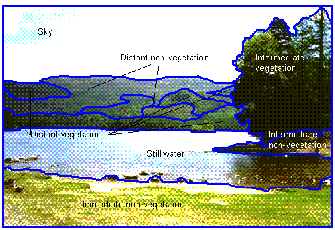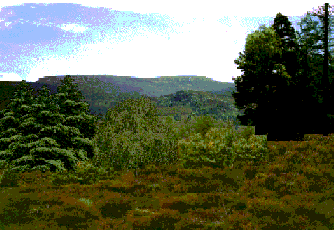 This page has been mothballed.
This page has been mothballed.
It is no longer being updated but we've left it here for reference.
Foot and Mouth Research
SyLViE
The visual assessment questionare on our website uses a tool developed within the Macaulay Land Use Research Institute, called SyLViE (A System for Landscape visualisation and evaluation). This page explains the thinking behind the system and how it works.
SyLViE combines a visualisation facility which uses dedicated software to simulate present and future landscapes with a predictive model for landscape preference, to produce a tool with which landscape change can be visualised while indicating the relative level of scenic beauty of the changed landscape.
This flowchart indicates the process which SyLViE follows.

 Example of the use of SyLViE
Example of the use of SyLViE
Existing landscape: Loch an Eilein, near Aviemore, Scotland.
Scenic preference score
Using the Shafer score (a pyschophysical landscape preference model described in Shafer et al., 1969) a scenic preference score was obtained for this landscape. The landscape is divided into three distance zones and then subdivided into three land cover types. The areas and perimeters of these components are measured.
On a scale of 50 (very scenic) to 250 (not scenic), this landscape scored 121.
 Distance Zones
Distance Zones
- Immediate
- Intermediate
- Distant
Land Cover Types
- Vegetation (trees and shrubs)
- Non-vegetation (rock, grasses)
- Water (lochs, rivers)
 Revised scenic preference score
Revised scenic preference score
In order to show how the general public might react to this proposed landscape change, the Shafer score is recalculated from the simulated landscape image.
The preference score for this landscape is 167. This is a less scenic score than for the original landscape. The proposed management change would therefore reduce the aesthetic appeal of this landscape.
Conclusion
A psychophysical landscape preference model can be combined with landscape visualisation to create a decision support tool, which is able to indicate the effects of a proposed management change on public preference for landscapes.
Reference: Shafer, E.L.; Hamilton, J.F. & Schmidt, E.A. (1969) Natural landscape preference: a predictive model. Journal of Leisure Research, 1: 1-19
Visualisation Techniques for Landscape Evaluation: A joint PhD project between the Macaulay Land Use Research Institute and Robert Gordon University

